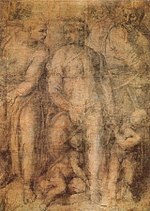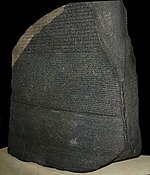Wikipedia:GLAM/British Museum/Featured Article prize
| British Museum Featured Article prizes | |
|---|---|
 |
In 2010 the British Museum offered five prizes of £100 (≈$140USD/€120) at their shop/bookshop for new Featured Articles on topics related to the British Museum in any Wikipedia language edition. Ideally, the topics were articles about collection items. This was the first time an organisation in the UK had put out a prize that recognises the value of fine articles on Wikipedia. This was a recognition that Wikipedia work is not only good quality but is consistent with the outreach aspect of the Museum's mission to engage the public. It had a positive effect for the Museum in terms of usage of the deeper resources and links back to their research material. It was a win–win situation for free cultural products, and more broadly for the cultural sector. The museum has curators dedicated to answering phone and email questions about their specialist areas and they recognise that editing Wikipedia articles, especially about items in the BM's collections, counts for those purposes. If you require assistance in approaching the British Museum curators, please contact Liam Wyatt (User:Witty lama) |
Note: five years on The winners are listed below, but the format of this page did not require articles being worked on to be listed. With hindsight this was a pity. As well as the winners, many other articles were worked on, and several also became Featured Articles. In English these included Lindow Man, Sweet Track, Harpy Tomb, and Rosetta Stone, which the winners (for the Latin version) did in English. Cyrus Cylinder was greatly improved, but because of controversies inherent in the subject remains a Good Article. (others? please add). Johnbod (talk) 15:19, 19 March 2015 (UTC)
Good places to start
[edit]You might want to start by looking at the British Museum's "highlights" page and sorting "by culture" or "by place" relevant to your own culture/history/language. You could look at the current major project at the museum "A History of the World in 100 Objects" or the existing English Wikipedia articles in Category:Collection of the British Museum to see whether there is something that interests you there.
You can also have a look at the matrix of articles related to the British Museum sorted by quality - listed here. That way you can find ones that are already good to start with!
The English Wikipedia page WP:GLAM/BM is the clearing house for the BM's involvement with Wikipedia; you can find more information about the project there or by emailing (User:Witty lama).
Details
[edit]- This prize is for articles directly related to the British Museum, especially about any object in the collection. There are potentially other subjects (such as famous former curators or famous parts of the building itself) that could potentially also be eligible for the prize – if in doubt, ask.
- Limit of one prize per person
- Limit of one prize per article – people can choose to share a prize if they collaborated on it.
- The prizes are available until all are claimed. You do not have to "register" beforehand but it would be good if you could tell Witty lama what you are doing so he can help you.
- In the event that multiple users claim a prize for the same article, they will need to agree among themselves how to allocate the prize.
Winners!
[edit]1) Royal Gold Cup Johnbod (talk) 13:09, 3 July 2010 (UTC)
2) Epifania de Miquel Àngel (User:MarisaLR) (posted by --Mafoso (talk)) 08:32, 6 July 2010 (UTC))
3) Tabula Rosettana Andrew Dalby (working with Iustinus, Neander and Captmondo) 09:30, 7 July 2010 (UTC)
4) Bronzes de Benín (Joancreus) (posted by--Mafoso (talk)) 14:55, 14 July 2010 (UTC)
5) La gran ola de Kanagawa (by Rαge) -- Màñü飆¹5 talk 00:39, 15 July 2010 (UTC)
The Articles | |
|
 The Royal Gold Cup or Saint Agnes Cup is a solid gold covered cup lavishly decorated with enamel and pearls. It was made for the French royal family at the end of the 14th century, and later belonged to several English monarchs, before spending nearly 300 years in Spain. Since 1892 it has been in the British Museum, and is generally agreed to be the outstanding survival of late medieval French plate. It has been described as "the one surviving royal magnificence of the International Gothic age", and to Thomas Hoving, former director of the Metropolitan Museum of Art in New York, "of all the princely jewels and gold that have come down to us, this is the most spectacular—and that includes the great royal treasures." |
 Epifania és un dibuix en carbonet de l'artista del renaixement italià Michelangelo Buonarroti, datat circa 1550-1553. Està realitzat sobre vint-i-sis làmines de paper amb unes dimensions de 232 cm d'altura per 165 cm d'amplada. El dibuix consta de cinc personatges principals amb algunes altres figures menys definides al fons de l'obra. Després d'haver passat per diversos propietaris, el dibuix es conserva actualment a la sala 90 del Museu Britànic. Se l'identifica amb la referència PD 1895-9-15-518. |
|
 Tabula Rosettana est stela decreto de rebus sacris in Aegypto anno 196 a.C.n. lato inscripta. Tabula iuxta Rosettam Aegypti, urbem in delta Nili et ad oram maris Mediterranei iacentem, anno 1799 a milite Francico reperta est. Inventio stelae, linguis duabus et scripturis tribus inscriptae, eruditis Instituti Aegypti statim nuntiata est; ibi enim iussu imperatoris Napoleonis eruditi omnium scientiarum (sub aegide Commissionis Scientiarum et Artium) properaverant cum expeditione Francica. Qua a Britannis mox debellata, tabula Rosettana Londinium missa hodie apud Museum Britannicum iacet. |
 Els bronzes de Benín són una col·lecció formada per més de 1.000 peces commemoratives que provenen del palau reial del regne de Benín. Van ser creades pels pobles Edo des del segle XIII, i els britànics se'n van apoderar de la majoria el 1897. 200 d'aquestes es van dur al Museu Britànic, mentre que la resta es van repartir entre altres museus. Actualment una part encara es troba al Museu Britànic, a la sala 25 (secció d'Àfrica). D'altres parts es troben als Estats Units i Alemanya, entre altres. |
|
 La gran ola de Kanagawa (神奈川沖浪裏, Kanagawa oki nami ura, literalmente «Bajo una ola en altamar en Kanagawa»), también conocida simplemente como La ola o La gran ola, es una famosa estampa japonesa del pintor especialista en ukiyo-e, Katsushika Hokusai, publicada entre 1830 y 1833, durante el período Edo de la historia de Japón.
| |
Any questions
[edit]---add yours here---
- I'd like to see British Museum Reading Room become an FA; anyone want to help? -- phoebe / (talk to me) 18:24, 13 June 2010 (UTC)
- I certainly think that would be an article worthy of FA. I don't think I could be of much help, I know little about it, am located in Yorkshire and a bit limited with time. I am however watching this ground-breaking project with great interest and wish you the best of look. Mtaylor848 (talk) 09:17, 16 June 2010 (UTC)
- Would getting List of directors of the British Museum up to FL status qualify for the award? Remember (talk) 15:10, 17 June 2010 (UTC)
- It's a list article, so it's not really the same thing as a prose article, but more importantly I'd really like to avoid making this about the institution or the staff of the institution as that might become CoI etc. Rather, if we could focus on the objects or subject areas that would be something where the BM and WP can collaborate without POVs getting in the way. Witty Lama 12:38, 18 June 2010 (UTC)
- Would getting List of directors of the British Museum up to FL status qualify for the award? Remember (talk) 15:10, 17 June 2010 (UTC)
- fair game or not -- first, artists who made the works? Second, what about a poet who wrote a poem that is not in the BM, but inspired a painting that is? Third, certain very specific genres or schools of art, which are represented in the museum? Fourth, cultures represented in the museum's works? And so on...? • Ling.Nut 15:18, 18 June 2010 (UTC)
- All potentially really interesting and valid encyclopedic topics, but pushing the boundaries of relevance to the BM... Of course, if you wanted to write about these I could definitely try to put you in contact with a curator in that subject area. Have a look at Category:British Museum and especially Category:British Museum-related articles by importance. A good rule of thumb would be any article that appears in the "top", "high" or "mid" importance categories or ANY museum object (some of which are in the "low" importance category or the article has not yet been created at all). Witty Lama 16:05, 18 June 2010 (UTC)
- Category:A History of the World in 100 Objects is up for deletion here. • Ling.Nut 03:33, 20 June 2010 (UTC)
- Whether or not the category stays, the articles within it will stay, so that does not affect this project fortunately :-) Witty Lama 09:38, 20 June 2010 (UTC)
- (in French) Quelqu’un serait intéressé pour un AdQ sur la Wikipédia francophone ? (in English) Anyone interrested for an FA on the french speaking Wikipedia? Cdlt, VIGNERON * discut. 12:53, 25 June 2010 (UTC)
